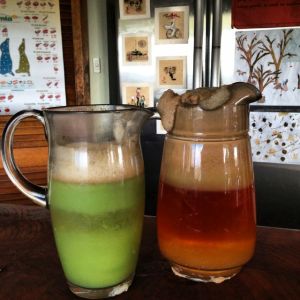I’ll start with something most of us can agree on – Coles are hypocrites. A partnership to sell bags for the Animals Australia ‘Make it Possible’ campaign to ‘end factory farming’ is a fairly brazen case of corporate whitewashing (or greenwashing, or whatever colour makes them look like ethical corporate citizens). If Coles supported the Make it Possible campaign by, say, refusing to sell pork and poultry from intensive production systems, that would constitute a meaningful ethical contribution. Selling bags aimed at ending ‘factory farming’ while intensively grown pork and poultry are on the shelves is, by definition, hypocritical.
But let’s put that aside for a moment. Surely any promotion of more ethical animal husbandry is a step in the right direction, even if it comes from one of the biggest sellers of what many deem unethical production systems? Meh, who knows. But what we do know is that most Coles supermarkets still don’t even offer free-range pork on their shelves, and their free-range poultry options, when they exist at all, are of dubious standards. So do these bags actually advocate that we don’t shop at Coles for pork and poultry? Ironically, it would seem so.
If you want to see an example of ethical meat retailers making a real difference, check out the wonderful folks at Feather and Bone, who endured some backlash for their support for the Voiceless Eyelevel project aimed at reducing Australians’ meat consumption. They have explained their intentions eloquently, while re-iterating their strong support and advocacy for free-range producers.
While we’re all in furious agreement over the gobsmacking hypocrisy of Coles, I’ll move on to a more vexed question – why are farmers so outraged at Coles’ support for a campaign to end intensive animal farming?
It seems that the root of their concerns is that Animals Australia is ‘anti-animal-farming’. I have had some reservations about the group, but most are probably groundless, and may actually just be an unfortunate association with the vegan abolitionist organisation, People for the Ethical Treatment of Animals (PETA). Even most vegans I know don’t agree with PETA’s tactics, such as these awful ads.
I’ve seen Animals Australia referred to as a ‘vegan front group’, with a ‘vegan agenda’ that wants us all to stop eating meat, wearing leather, or using any part of an animal or its labour for our own purposes. This agenda, which is more accurately referred to as a vegan abolitionist agenda such as that promoted by PETA, is quite obviously at serious odds with the agenda of a livestock farmer. It is also at odds with the agenda of Coles and any other purveyor or consumer of animal products. It is also a very very small minority of the population who support this agenda. (Note that not all vegans are abolitionists, and some actively fight alongside ethical omnivores to promote more ethical animal husbandry.) So why the outrage? What real threat is there to farmers?
Some (including Animals Australia) have said that farmers don’t want to move away from intensive production systems, and are afraid to let consumers see the realities of their systems for fear of backlash, and that’s why they don’t like the Make it Possible campaign. And for some intensive producers, I’m sure that must be true.
But for the many many more extensive growers – sheep and cattle farmers for example (the vast majority of which are pasture-based systems in Australia) I think you can take their word at face value – they’re sick of being attacked by vegan abolitionists, and rightly or wrongly believe Animals Australia shares that agenda ultimately. Having been on the receiving end of the abuse that comes from those quarters, I can fully empathise with their sensitivity.
Tactically, though, I think the National Farmers Federation (NFF) made a mistake in so vehemently opposing the Coles/Animals Australia cross-promotion. Everyone can see that Coles are hypocrites, and no friend to farmers and rural communities. So who cares if they sell bags for a campaign that wants to ‘end factory farming’ – some of these bags will even carry ‘factory farmed’ meat, I imagine?!
Opposing the partnership may have served merely to make the NFF and its supporters look ‘pro factory farming’. But as I’ve already posited, I suspect most who opposed it are in fact just fed up with attacks from vegan abolitionists and attempts to destroy their livelihood (about which, of course, intensive producers are also concerned – these are real people paying real bills too. One may have less sympathy for their position, but surely we cannot ignore the social costs of food systems in transition as part of our ethical considerations. More on this in a future post.).
The only farmers under direct threat from the campaign are the intensive producers, and they’ve been under pressure for years as consumers gained greater awareness of the conditions and started voting with their dollars, first for free-range eggs, then chicken, and now pork. There’s a long way to go before we see all animals raised in conditions that are truly acceptable to the majority of the population, and most people’s budget will still dictate their purchasing habits ahead of their ethics. Financial reality is a difficult stakeholder to overrule, and shopping ethically takes a certain level of knowledge, will and culinary competence, not to mention transparency in the supply chain.
But as I wrote recently, the real losers in this stoush are animals in intensive production systems. The myopic vitriol of the vegan abolitionists, the defensiveness of the NFF, and the stunning hypocrisy of Coles won’t improve animal welfare on Australian farms – growers and eaters will with our choices and through respectful dialogue.
I take my hat off to the many growers and eaters across the country who are working to be the changes they wish to see in the world. I reckon Coles and proselytising vegan abolitionists, on the other hand, need to learn some lessons from Gandhi.



















